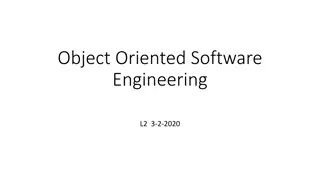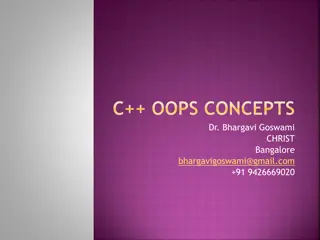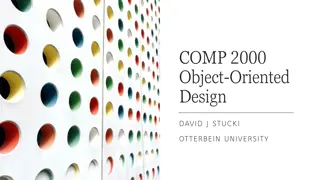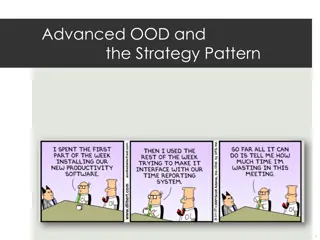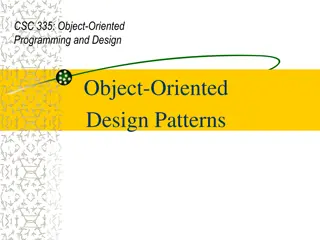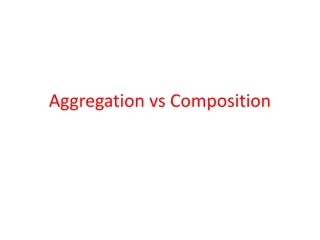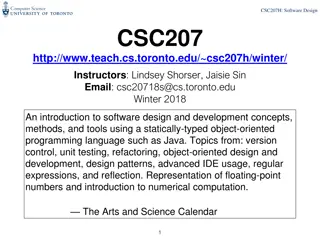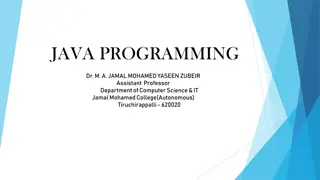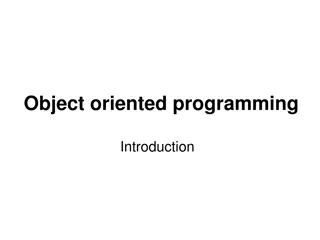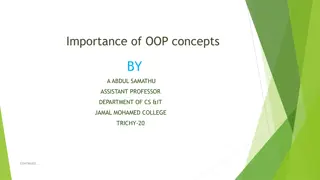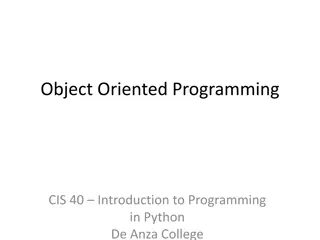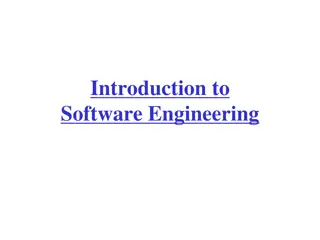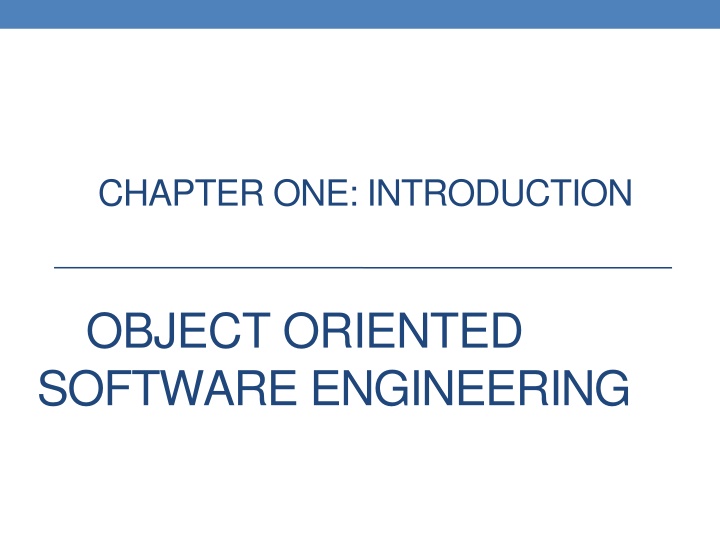
Introduction to Object Oriented Software Engineering
Object Oriented Software Engineering explores the nature of software, software engineering concepts, and the importance of quality in software development. It covers the basics of object oriented systems development and emphasizes the need for proper design to address the challenges in software development.
Download Presentation

Please find below an Image/Link to download the presentation.
The content on the website is provided AS IS for your information and personal use only. It may not be sold, licensed, or shared on other websites without obtaining consent from the author. If you encounter any issues during the download, it is possible that the publisher has removed the file from their server.
You are allowed to download the files provided on this website for personal or commercial use, subject to the condition that they are used lawfully. All files are the property of their respective owners.
The content on the website is provided AS IS for your information and personal use only. It may not be sold, licensed, or shared on other websites without obtaining consent from the author.
E N D
Presentation Transcript
CHAPTER ONE: INTRODUCTION OBJECT ORIENTED SOFTWARE ENGINEERING
Requirements for this Course You may be proficient in a programming language, but you have no or limited experience in analysis or design of a system You want to learn more about the technical aspects of analysis and design of complex software systems Objectives of the Course Appreciate Software Engineering: Build complex software systems in the context of frequent change Understand how to produce a high quality software system within time while dealing with complexity and change Acquire technical knowledge (main emphasis)
OUTLINE The Nature of Software What is Software Engineering?. Software Engineering and the Engineering Profession Stakeholders in Software Engineering Software Quality Activities Common to Software Projects An Overview of Object Oriented Systems Development Object Basics Object Oriented Systems Development Life Cycle
1.1. The Nature of Software Software is intangible Hard to understand development effort Software is easy to reproduce Cost is in its development - in other engineering products, manufacturing is the costly stage The industry is labor-intensive Hard to automate
The Nature of Software ... Untrained people can hack something together Quality problems are hard to notice Software is easy to modify People make changes without fully understanding it Software does not wear out It deteriorates by having its design changed: erroneously, or in ways that were not anticipated, thus making it complex Conclusions Much software has poor design and is getting worse Demand for software is high and rising We are in a perpetual software crisis We have to learn to engineer software 6
Types of Software Custom For a specific customer Generic Sold on open market Often called COTS (Commercial Off The Shelf) Shrink-wrapped Embedded Built into hardware Hard to change 7
Types of Software Differences among custom, generic and embedded software Custom Number of copies in use Total processing power devoted to running this type of software Worldwide annual development effort Generic medium Embedded high low low high medium high medium low 8
Types of Software Real time software E.g. control and monitoring systems Must react immediately Safety often a concern Data processing software Used to run businesses Accuracy and security of data are key 9
1.2 What is Software Engineering? The process of solving customers problems by the systematic development and evolution of large, high-quality software systems within cost, time and other constraints Other definitions: IEEE: (1) the application of a systematic, disciplined, quantifiable approach to the development, operation, maintenance of software; that is, the application of engineering to software. (2) The study of approaches as in (1). The Canadian Standards Association: The systematic activities involved in the design, implementation and testing of software to optimize its production and support. 10
What is Software Engineering? Solving customers problems This is the goal of software engineering Sometimes the solution is to buy, not build Adding unnecessary features does not help solve the problem Software engineers must communicate effectively to identify and understand the problem Systematic development and evolution An engineering process involves applying well understood techniques in a organized and disciplined way Many well-accepted practices have been formally standardized e.g. by the IEEE or ISO Most development work is evolution 11
What is Software Engineering? Large, high quality software systems Software engineering techniques are needed because large systems cannot be completely understood by one person Teamwork and co-ordination are required Key challenge: Dividing up the work and ensuring that the parts of the system work properly together The end-product must be of sufficient quality 12
1.3 Software Engineering and the Engineering Profession The term Software Engineering was coined in 1968 People began to realize that the principles of engineering should be applied to software development Engineering is a licensed profession In order to protect the public Engineers design artifacts following well accepted practices which involve the application of science, mathematics and economics Ethical practice is also a key tenet of the profession 13
Software Engineering and the Engineering Profession Ethics in Software Engineering: Software engineers shall Act consistently with public interest Act in the best interests of their clients Develop and maintain with the highest standards possible Maintain integrity and independence Promote an ethical approach in management Advance the integrity and reputation of the profession Be fair and supportive to colleagues Participate in lifelong learning 14
1.4 Stakeholders in Software Engineering 1. Users Those who use the software 2. Customers Those who pay for the software 3. Software developers 4. Development Managers 15
1.5 Software Quality... Usability Users can learn it and fast and get their job done easily Efficiency It doesn t waste resources such as CPU time and memory Reliability It does what it is required to do without failing Maintainability It can be easily changed Reusability Its parts can be used in other projects, so reprogramming is not needed 16
1.6 Activities Common to Software Projects... Requirements and specification Includes Domain analysis Defining the problem Requirements gathering Obtaining input from as many sources as possible Requirements analysis Organizing the information Requirements specification Writing detailed instructions about how the software should behave 17
Activities Common to Software Projects... Design Deciding how the requirements should be implemented, using the available technology Includes: Systems engineering: Deciding what should be in hardware and what in software Software architecture: Dividing the system into subsystems and deciding how the subsystems will interact Detailed design of the internals of a subsystem User interface design Design of databases 18
Activities Common to Software Projects Modeling Creating representations of the domain or the software Use case modeling Structural modeling Dynamic and behavioral modeling Programming Quality assurance Reviews and inspections Testing Deployment Managing the process 19
1.7 Difficulties and Risks in Software Engineering Complexity and large numbers of details Uncertainty about technology Uncertainty about requirements Uncertainty about software engineering skills Constant change Deterioration of software design Political risks 20
Object-oriented analysis anddesign Object-oriented analysis and design (OOAD) is a popular technical approach for analyzing, designing an application, system, or business by applying the object oriented paradigm and visual modeling throughout the development life cycles for better communication and product quality. Object-oriented programming (OOP) is a method based on the concept of objects", which are data structures that contain data, in the form of fields, often known as attributes; and code, in the form of procedures, often known as methods.
Continued What is OOAD?- Object-oriented analysis and design (OOAD) is a software engineering approach that models a system as a group of interacting objects . Analysis understanding, finding and describing concepts inthe problem domain. Design understanding and defining software solution/objects that represent the analysis concepts and will eventually be implemented in code. OOAD - A software development approach that emphasizesa logical solution based on objects. Software development is dynamic and always undergoing major change.
Continued System development refers to all activities that go into producing information system solution. System development activities consist of system analysis, modelling, design, implementation, testing and maintenance. A software development methodology series of processes can lead to the development of an application. Practices, procedures, and rules used to develop software, totally based on system requirements
ORTHOGONALVIEWSOFTHESOFTWARE TwoApproaches, TraditionalApproach Objected-OrientedApproach TRADITIONALAPPROACH Collection of programs orfunctions. A system that is designed for performing certain actions. Algorithms + Data Structures = Programs. Software Development Models (Waterfall, Spiral, Incremental,etc..)
Object-oriented Approach Object Oriented Development is a new way of thinking about software based on abstractions that exist in the real world as well as in the program. Object Oriented Development is a method of design encompassing the process of object-oriented decomposition and a notation for depicting logical and physical as well as static and dynamic models of the system under design.
OBJECT-ORIENTED APPROACH An approach to the solution of problems in which all computations are performed in the context of objects. The objects are instances of classes, which: -are data abstractions -contain procedural abstractions that operate on the objects A running program can be seen as a collection of objects collaborating to perform a given task
Continued OBJECT ORIENTEDAPPROACH OO development offers a different model from the traditional software based on functions and procedures. software is a collection of discrete object that encapsulate their dataaswell as the functionality. Each object has attributes (properties) and method (procedures). software by building self contained modules or objects that can beeasily REPLACED, MODIFIED ANDREUSED. Objects grouped in to classes and object are responsible foritself.
EXAMPLESOFOBJECTORIENTEDSYSTEMS In OO system , everything is object . A spreadsheet cell, bar chart, title in bar chart, report, numbers, arrays, records, fields, files, forms, an invoice, etc. A window object is responsible for things like opening, sizing, and closing itself. A chart object is responsible for things like maintaining data and labels even for drawing itself.
BENEFITSOFOBJECTORIENTATION Faster development, Reusability, Increased quality modeling the real world and provides us with the stronger equivalence of the real world s entities (objects). Raising the level of abstraction to the point where application can be implemented in the same terms as they are described.
WHY OBJECTORIENTATION OO Methods enables to develop set of objects that work together software similar to traditional techniques. It adapts to Changing requirements Easier to maintain More robust Promote greater design Code reuse
Continued Others Higher level of abstraction Seamless transition among different phases of software development. Encouragement of good programming technique. Promotion of reusability.
TRADITIONAL APPROACH The traditional view of a computer program is that of a process that has been encoded in a form that can be executed on a computer. This view originated from the fact that the first computers were developed mainly to automate a well-defined process (i.e., an algorithm) for numerical computation, and dates back to the first stored-program computers. Accordingly, the software creation process was seen as a translation from a description in some natural language to a sequence of operations that could be executed on a computer.
TRADITIONAL APPROACH The process-centred approach used to software development is called top-down functional decomposition. The first step in such a design was to recognise what the process had to deliver (in terms of input and output of the program), which was followed by decomposition of the process into functional modules.
TRADITIONAL APPROACH.. As many would argue, this paradigm is still the best way to introduce the notion of programming to a beginner, but as systems became more complex, its effectiveness in developing solutions became suspect. This change of perspective on part of the software developers happened over a period of time and was fuelled by several factors including the high cost of development and the constant efforts to find uses for software in new domains(OOSE).
TRADITIONAL APPROACH The traditional approach to software development tends toward writing a lot of code to do all the things that have to be done. Algorithmic Centric Methodology only the algorithm that can accomplish the task. Data-Centric Methodology - think about the data to build a structure based on the algorithm You are the only active entity and the code is just basically a lot of building materials.
Objects The concepts of objects and classes are intrinsically linked with each other and form the foundation of object oriented paradigm. Identity that distinguishes it from other objects in the system. State that determines the characteristic properties of an object as well as the values of the properties that the object holds. Behavior that represents externally visible activities performed by an object in terms of changes in its state.
Class A class represents a collection of objects having same characteristic properties that exhibit common behavior. Creation of an object as a member of a class is called instantiation. Thus, object is an instance of a class. Example: Circle a class x, to the center a, to denote the radius of the circle Some of its operations can be defined as follows: findArea(), method to calculate areafindCircumference(), method to calculate circumference
Object orientedMethodologies Many methodologies have been developed for object oriented development. A methodology usually includes Notation : Graphical representation of classes andtheir relationships with interactions. Process : Suggested set of steps to carry out for transforming requirements into a working system. Tool (CASE): Software for drawings and documentation
OVERVIEWOFUNIFIEDAPPROACH(UA) The unified approach (UA) is a methodology for software development. Booch, Rumbaugh, Jacobson methodologies gives the best practices, processes and guidelines for OO oriented software development. Combines with the OMT (Object Modeling Technique in Unified Modelling Language(UML). UA utilizes the unified modeling language (UML) which is a set of notations and conventions used to describe and model an application.
Continued LayeredArchitecture UA uses layered architecture to developapplications. Creates object that represent elements to the user through interface or physically stored in database. The layered approach consists of user interface, business, access layers. This approach reduces the interdependence of the user interface, database access and business control. More robust and flexible system.
UML Unified modeling language: Introduction UML is a notation that resulted from the unification of OMT (Object Modeling Technique). The goal of UML is to provide a standard notation that can be used by all object-oriented methods and to select and integrate the best elements of precursor notations(OMT & OOSE). For example, UML includes the use case diagrams introduced by OOSE and uses many features of the OMT class diagrams. UML also includes new concepts that were not present in other major methods at the time, such as extension mechanisms and a constraint language. UML has been designed for a broad range of applications.
UML Unified modeling language: Introduction Hence, UML provides constructs for a broad range of systems and activities (e.g., distributed systems, analysis, system design, deployment). System development focuses on three different models of the system. The functional model, represented in UML with use case diagrams, describes the functionality of the system from the user s point of view. The object model, represented in UML with class diagrams, describes the structure of the system in terms of objects, attributes, associations, and operations. The dynamic model, represented in UML with interaction diagrams, state diagrams, and activity diagrams, describes the internal behavior of the system.
UML Unified modelinglanguage: Introduction UML focuses on standard modeling language and not a standard process. UML focuses the concept of Booch, Rambaugh and Jacobson. The UML is a standard graphical design for object- oriented graphical design and a medium for presenting important analysis and design concepts.
UMLDiagrams Use Case Diagrams Class Diagrams Package Diagrams Interaction Diagrams Sequence Collaboration Activity Diagrams State Transition Diagrams Deployment Diagrams
Introduction Use-cases are descriptions of the functionality of a system from a userperspective. Depict the behaviour of the system, as it appears to an outside user. Describe the functionality and users (actors) of thesystem. S how the relationships between the actors that use the system, the use cases (functionality) they use, and relationship between different usecases. Document the scope of thesystem. Illustrate the developer s understanding requirements. of the user s

